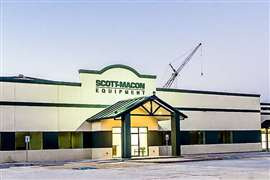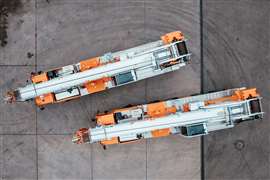top 10 tips
24 April 2008

In conducting training on aerial work platforms (AWP) since 1992 I've had many people in training sessions with varied experience. From “never been on one of these things” to “I've been operating these things since before you were born”. Which in my case, would make you pretty old.
With the varied experience and many classes and the thousands of people who have attended these sessions I've come up with some 'must know' items that even experienced operators may not know or may not have thought about. By no means is this a complete list, so get training.
Aerial work platform operators need to know a lot of things about the lift they are using and the site conditions where the lift is going to be used. So the first ‘must know' item is training.
1. Training
Most jobsites now require some sort of AWP training before contractors on site will be allowed to operate the lifts to do their work. Some governmental agencies may require this training as well. But realistically do we need the government to tell us to train our people. Training is morally the “right thing to do.”
There are many training programs out there and most companies who rent AWPs offer this training. As well, the International Powered Access Federation and its affiliate in the States, the AWPT, can help direct you to one of their members for formal AWP training. Contact www.ipaf.org for more information.
2. Read the operator's manual
This seems like a no brainer, but in reality hardly ever happens. Even when an operator encounters a problem with the lift, pulling out the manual and reading it just doesn't happen. I believe this is a macho thing, “Real men don't read instructions.” Yet, in this day and age it is virtually impossible to know how each lift operates or is supposed to operate without reading the manual for that lift.
I train people on these lifts and have been on hundreds of them and I cannot keep up with the controls and functions of them all without pulling out the manual and looking them up. I have often times actually pulled out the manual with students standing there while I verify or look something up. You're not less of a man for doing this. It might just save your life or at the very least save you some time and money. As well, there should always be an operator's manual (and in the US an ANSI Manual of Responsibilities) on the lift, usually inside a waterproof box.
3. Pre-start inspection
If you have read the instructions or had training you would already know this one. A pre-start inspection is just like a pilot's pre-flight check. Going up 20 ft in a scissor lift or 30000 ft in a jet, if you crash the results are usually the same. Pre-start inspections cover many items on the AWP and also check to make sure you have all your personal protective equipment like hardhat, work boots, safety glasses, etc. This requires a visual walk around as well as function checks of all the controls on the machine. Usually there is a detailed list of things to checks in, you guessed it, the Operator's Manual.
4. Workplace inspection
This involves knowing what the lift weighs and the ground pressure of the tires/wheels on the ground or surface. Then literally walking the worksite area to make sure the surface on which the lift will be operated will support the AWP. Pick up debris, note any obstacles, drop-off, holes, overhead obstacles, power lines, moving machinery or overhead cranes, etc.
5. Stay away from power-lines
AWPs are not insulated from electrical shock from power-lines, transformers, power poles, overhead crane bus bars, and anything else that can conduct electricity. Most regulatory agencies and governing bodies require you to stay at least 10 ft (3 m) away from all power-lines and power parts. This will always include materials handled on the AWP as well. For instance if you are handling pipe or steel stud that will go outside the perimeter of the basket you need to add 10 ft to the distance the material will protrude outside the basket. Put an imaginary bubble measured 10 ft out from the line all the way around it. You cannot pierce the bubble.
6. Direction of travel arrows
Many operators have seen the arrow decals on the boom lift chassis and may have even noticed the arrow indicators near the drive control joystick, but do not know what they are there for or how to use them. Since you can rotate a boom lift 180 degrees around to the opposite side, the drive control joystick is now reversed, so when you push the drive control joystick away from you, you will go backwards to how you are facing, and when you pull it towards you it will go in the opposite direction or forwards.
This can be a problem if you do not remember which way you drove the lift the last time you drove it. If you should drive in the wrong direction you could run into a wall, over someone or off the surface you are driving, all catastrophic events. Before you ever drive a lift, get into the habit of looking first at the chassis arrows and say to yourself, “which way do I want the chassis to move, white arrow or black arrow direction.” If you want to move in the white arrow direction then move the drive control joystick in the white arrow direction according to the arrows on the control panel.
7. Battery charging and fuel problems
Probably the most common reason for a service call, “It was plugged in all night and it is not charged.” Reasons that an electric AWP does not charge: not plugged in to the battery charger, usually plugged into the power to the platform cord which will not charge the batteries. No power to the cord, blown GFCI or circuit breaker or a bad extension cord. Or my favourite - the power on the jobsite is shut off for the night sometime after the jobsite is vacated. And last, check the batteries for water.
Other fueling problems - and a close second to battery charging service calls - is the user putting the wrong fuel into the lift. Putting gas into a diesel engine machine, putting diesel into a gas engine machine, and also putting fuel into the hydraulic tank, another favorite of mine. All very expensive service calls too.
8. Emergency descent controls
All AWPs are equipped with a way to get you down if something should go wrong. Read the manual. These controlled descent or emergency descent controls are different for many AWPs. Not only do you need to know how these operate, but someone on the ground needs to know too so they can get you down in case something would happen to you while you're elevated.
9. Annual and frequent inspections
Both the AWP manufacturers and ANSI (in the US) require that these be done by a factory trained technician. Consult the operator's and maintenance manual on the AWP for this procedure. Annual inspection dates should be noted on the AWP somewhere.
10. Don't operate a lift that is not operating properly
If during your pre-start inspection or at any time you are operating the AWP something does not seem right, shut the AWP down, take the key out and tag the machine as ‘DOWN, DO NOT USE' until a trained service technician can inspect it.
These ten things are by no means everything you need to know to operate an AWP safely. We hope though that if you are reading this, these ten reminders will help you make the right decisions the next time you are going to buy, rent, use or operate an aerial work platform.



